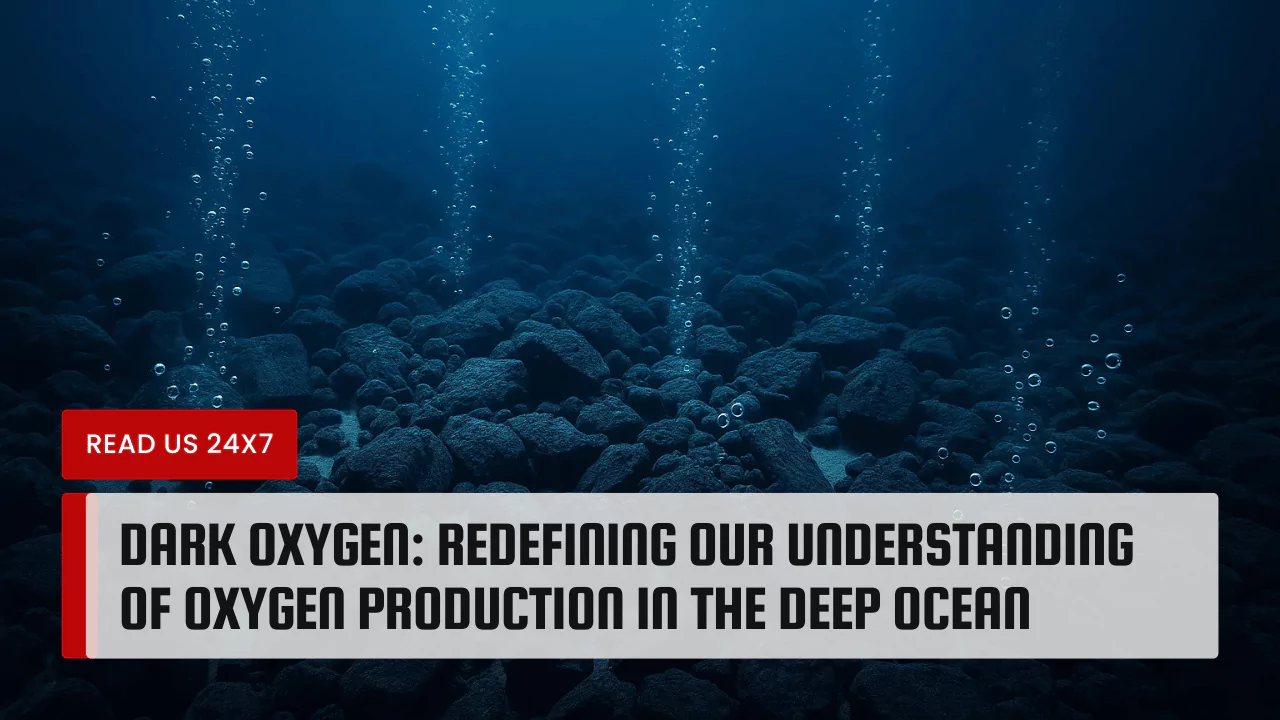The newly uncovered process of generating “Dark Oxygen” in the depths of our oceans is an active production zone that challenges existing beliefs on how oxygen is generated on our planet.
Dark oxygen is produced through the oxygen production in the ocean’s depths, which does not include phototropism. It is a process especially noticeable in regions where sunlight cannot reach at high altitudes.
Transformations of Earth’s life will be impacted deeply by these findings, besides the fundamental understanding of the Earth’s oxygen cycle.
The Definition and Discovery of Dark Oxygen
The phrase ‘dark oxygen production’ refers to the generation of molecular oxygen (O₂) without any processes making use of the light-dependent efforts of oxygenic photosynthesis. The term is differentiated from the understanding that oxygen production is achieved with the use of light and hence distinguishes it from the term “dark” being used photometrically.
An interdisciplinary approach in biological oceanography and geology led to this astonishing finding when researchers monitoring the dominant shallow seafloor ecosystems in the central Pacific Ocean discovered unusual increases of oxygen in their experimental chambers set on the seabeds at about 4,000 meters below sea level. SAMS’s Andrew Sweetman led the research and made the first observations as early as 2013, but cast them aside as they went against well-known scientific knowledge.
“I first saw this in 2013 – an enormous amount of oxygen being produced at the seafloor in complete darkness,” explained Sweetman. “I just ignored it, because I’d been taught – you only get oxygen through photosynthesis.”
Years later, after consistent experimental results, Sweetman’s team published their findings in Nature Geoscience in July 2024, documenting how oxygen levels in benthic chamber incubations increased over two days to more than three times the background concentration.
Historical Understanding of Oxygen Production
Before this discovery, scientists thought Earth’s oxygen originated solely with the photosynthetic activity of plants, algae, and some bacteria. The understanding was that about half of the oxygen we breathe came from the ocean, produced through photosynthesis by marine plants and microorganisms, organisms that also require sunlight.
Oxygen in deep oceans where light does not reach was considered to come from currents circulating oxygen from the ocean’s surface. The discovery of oxygen’s dark production at abyssal depths radically contradicts this longstanding scientific belief.
Mechanisms of Dark Oxygen Production
The Polymetallic Nodule Mechanism
The primary polymetallic mechanisms contributing to this process appear to be related to dark oxygen production in the deep sea. These, on the ocean floor, are lumps of metals deep sea, containing, to mention manganese, iron, cobalt, ores like magnesium, nickel, copper, and lithium, on a side parallel to their potato-sized structure.
Through an electrochemical process, researchers hypothesize is analogous to electrolysis where oxygen is produced. Water molecules (H₂O) can be split into their components, hydrogen gas and oxygen, due to the voltage potentials (up to 0.95 V) from the surface nodules. To put it simply, the metal nodules act as batteries in this case, producing electricity which will be used to power the transformation of water into its elements.
Other Known Mechanisms of Dark Oxygen Production
Beyond the polymetallic nodule mechanism, scientific literature identifies several other processes that can generate oxygen without photosynthesis:
Abiotic Production
Several abiotic processes can produce oxygen in dark environments:
- Water radiolysis: This process usually takes place in dark geological ecosystems like aquifers, where the radioactive decay of elements in surrounding rocks splits water molecules, yielding O₂.
- Oxidation of silicon-bound surface radicals: Surface-bound radicals can be oxidized on silicon-bearing minerals such as quartz, which also increases O₂ yield.
Such reactions normally yield reactive oxygen species (ROS) transformable to O₂ via numerous reactions.
Biotic Production
Some microorganisms can produce oxygen through distinct biological processes:
- The dismutation of chlorite: This includes the dismutation of chlorite (ClO₂⁻) into oxygen and chloride ions.
- Dismutation of nitric oxide: Ozone and nitrogen compounds are the daughter products of this process involving the dismutation of nitric oxide (NO).
The Clarion-Clipperton Zone Research
The underwater region Clarion-Clipperton Zone, is 4.5 million square kilometers large and lies between Mexico and Hawaii in the Pacific Ocean. It is reputed for having the highest concentration of polymetallic nodules on the seafloor. This region also houses the astonishing dark oxygen.
Experimental Methods and Findings
Scientists set autonomous research landers that shoved chambers into the sediment, which crafted microcosms of the sea floor. These chambers contained tools that recorded the oxygen levels every 10 seconds. The experiments were performed at approximately 4,000 meters (13,000 feet) under water where sunlight cannot reach.
Strikingly, the researchers noted that with each chamber, more oxygen was accumulating than what was being consumed by the organisms, and in 25 benthic chamber incubations, the expectation was placed that oxygen concentrations would decrease due to the sediment community oxygen consumption, yet the levels definitely increased.
The research was conducted in the Nauru Ocean Resources Inc. (NORI)-D license area situated in the central Clarion-Clipperton Zone (CCZ), extensively covered by polymetallic nodules, where his study was further aided by laboratory tests that affirmed the unexpectedly high yield of oxygen was indeed produced by the polymetallic nodules.
Scientific Significance and Implications
Challenging Our Understanding of Life’s Origins
The finding of dark oxygen production in the deep ocean regions is changing the theories deep-sea scientists have regarding the beginnings of aerobic life on Earth.
“For aerobic life to begin on the planet, there had to be oxygen, and our understanding has been that Earth’s oxygen supply began with photosynthetic organisms,” explained Andrew Sweetman. “But we now know that there is oxygen produced in the deep sea, where there is no light. I think we, therefore, need to revisit questions like: Where could aerobic life have begun?”
The findings propose the hypothesis that life forms could have evolved to metabolize oxygen generated by oxygen-demanding metals rather than exclusively relying on oxygen from the photosynthesizing cyanobacteria.
Implications for Extraterrestrial Life
The discovery of dark oxygen fundamentally changes the study of life beyond Earth. Scholars, including those from NASA, theorize that dark oxygen may change life-sustaining processes in other celestial bodies with no direct sunlight overriding the control mechanisms.
This is especially the case for the ocean moons within our Solar System ,like Europa, one of Jupiter’s moons, and Enceladus, a moon of Saturn, which are unable to receive sunlight necessary for photosynthetic chemical reactions but have vast oceans concealed beneath the surface. Should polymetallic concentrates on these worlds yield oxygen through analogous processes, oxygen-dependent life could thrive there.
The Controversy Surrounding Dark Oxygen
Scientific Skepticism
The discovery of dark oxygen has not been universally accepted within the scientific community. Some scientists have expressed skepticism about the findings and methodology.
The most notable criticism has come from The Metals Company, which partially funded the original research. The company has submitted a rebuttal to the Nature Geoscience paper, claiming that “After decades of research using the same methods, no credible scientist has ever reported evidence of ‘dark oxygen'”.
Ongoing Research Efforts
In response to the controversy, Professor Sweetman and his team have announced plans for a new research expedition to study the deepest parts of Earth’s oceans to further understand the dark oxygen phenomenon. The plan is to work at sites where the seabed is more than 10 kilometers (6.2 miles) deep, using remotely operated submersible equipment.
“We have instruments that can go to the deepest parts of the ocean,” explained Professor Sweetman. “We’re pretty confident we’ll find it happening elsewhere, so we’ll start probing what’s going on.”
This follow-up research aims to settle disputes and provide more definitive evidence about the mechanisms behind dark oxygen production.
Environmental and Industrial Implications
Deep-Sea Mining Concerns
The finding of dark oxygen matters a lot for deep-sea mining operations that focus on polymetallic nodules. A number of mining companies intend to harvest these nodules due to their precious metals, which are utilized in electric vehicle batteries and other low-carbon technologies.
Franz Geiger, a chemist from Northwestern University who led the electrochemistry experiments in the original study, expressed concern: “Several large-scale mining companies now aim to extract these precious elements from the seafloor at depths of 10,000 to 20,000 feet below the surface. We need to rethink how to mine these materials, so that we do not deplete the oxygen source for deep-sea life.”
Environmental Advocacy Perspectives
Explaining the need to halt deep-sea mining in the Pacific because of possible damage it may cause to vulnerable life forms, a Greenpeace member said, “This incredible discovery underlines the urgency of that call”. Environmental organizations have used the recently discovered dark oxygen zone as justification for their campaigns against deep-sea mining.
The discovery adds to the oxygen supply of the polymetallic nodule ecosystem and oxygen-producing complex, as well as adding to the ecological role of sustaining peculiar deep-sea life forms, thus complicating the assessment of the environmental consequences of mining operations even further.
Regulatory Considerations
The International Seabed Authority (ISA) oversees activity in deep-sea mining and has entered into contracts with different countries for exploring and possibly exploiting resources like polymetallic nodules. The dark oxygen discovery further complicates the development of regulations and environmental assessment for deep-sea mining.
Future Research Directions
Planned Deep-Sea Missions
Scientists are planning new expeditions focused specifically on understanding the dark oxygen phenomenon better. These missions will target the deepest parts of Earth’s oceans, using specialized equipment to measure and analyze oxygen production at extreme depths.
These future studies aim to address several key questions:
- How widespread is dark oxygen production in the world’s oceans?
- What exact mechanisms drive the electrochemical processes in polymetallic nodules?
- What marine life might depend on this oxygen source?
Collaboration with Space Agencies
The effects of dark oxygen on possible alien life have prompted partnerships with space organizations such as NASA. Understanding the production of dark oxygen on Earth, scientists believe, could inform the search for plausible sustained life on other planets, especially those with subsurface oceans.
Conclusion
The discovery of dark oxygen alters how we comprehend the processes of oxygen generation in Earth’s systems. The ability to produce oxygen in the absence of sunlight in the ocean’s deepest regions adds to the extant life theories on Earth, as well as the possibilities of life on other planets.
This finding disrupts theories regarding the generation of oxygen, enables alternative pathways about aerobic life history, and poses significant problems regarding deep-sea mining. From this occurrence, a known phenomenon may require far more advanced analysis, prompting us to reconsider our planet’s biogeochemical cycles in conjunction with life’s prerequisites.



